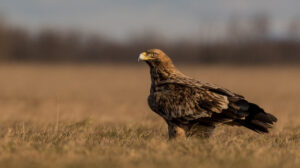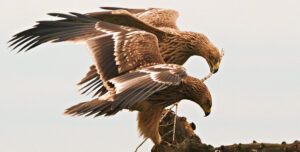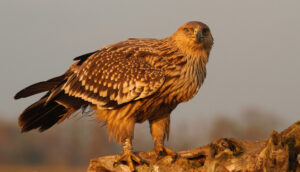Third International Scientific and Practical Conference “Eagles of the Palearctic: Study and Conservation”
Raptors Conservation. Suppl. 2. Proceedings of Conferences
Grassland Alterations Do Not Affect Breeding Success, But Lead to Dietary Shifts of Eastern Imperial Eagle, a Top Predator: a Case of Successful Adaptation
Demerdzhiev D.A. (Bulgarian Society for the Protection of Birds / Birdlife Bulgaria, Plovdiv;
National Museum of Natural History, Department of Zoology, Sofia, Bulgaria)
Dobrev D.D. (Bulgarian Society for the Protection of Birds / Birdlife Bulgaria, Plovdiv, Bulgaria)
Boev Z.N. (Bulgarian Society for the Protection of Birds / Birdlife Bulgaria, Plovdiv; National
Museum of Natural History, Department of Zoology, Sofia, Bulgaria)
Nedyalkov N.P. (National Museum of Natural History, Department of Zoology, Sofia, Bulgaria)
Delchev A.G., Stoychev S.A., Petrov T.H. (Bulgarian Society for the Protection of Birds / Birdlife Bulgaria, Plovdiv, Bulgaria)
Contact:
Dimitar Demerdzhiev dimitar.demerdzhiev@gmail.com
Dobromir Dobrev dobromir.dobrev@bspb.org
Zlatozar Boev zlatozarboev@gmail.com
Nedko Nedyalkov nnedko@gmail.com
Atanas Delchev atanas.delchev@bspb.org
Stoycho Stoychev stoycho.stoychev@bspb.org
Tseno Petrov petrow_ts@abv.bg
Recommended citation: Demerdzhiev D.A., Dobrev D.D., Boev Z.N., Nedyalkov N.P., Delchev A.G., Stoychev S.A., Petrov T.H. Grassland Alterations Do Not Affect Breeding Success, But Lead to Dietary Shifts of Eastern Imperial Eagle, a Top Predator: a Case of Successful Adaptation. – Raptors Conservation. 2023. S2: 290–294. DOI: 10.19074/1814-8654-2023-2-290-294 URL: http://rrrcn.ru/en/archives/35092
Habitat transformation is identified as a global threat to biodiversity, affecting threatened raptors. In our study area, habitat change dramatically affected permanent grasslands, shrinking their availability. As we expected, the decrease in share of grasslands in eagles’ territories significantly affected occupancy rate, but not productivity: we found that occupancy rate decreased significantly, while productivity showed no trend.
Understanding the adaptive capacity of top predators and how they respond to shifts in prey abundance and availability is crucial for their conservation. We investigated the diet pattern of the endangered Eastern Imperial Eagle (Aquila heliaca) facing long-term and large-scale changes. We studied the abundance variation of its profitable prey, European Souslik (Spermophilus citellus), and how it reflected on eagle population trajectories in a regional and temporal context. We found a significant diet alteration expressed in large decrease of brown hare (β2=-0.83), poultry (β2 =-0.81), gulls (β2=-0.71), and water birds (β2=-0.57) and an obvious increase of northern white-breasted hedgehog (β2=0.61) and doves (β2=0.60). Raptors, including owls, raised their share among the prey (β2=0.44), but white stork and different reptiles supplied more biomass. Abundance of European souslik decreased through the studied periods (adjusted R2=0,25, p<0.001), which accounted for the lower proportion of this prey in the eagle’s diet. Nevertheless, the eagle population successfully adapted and significantly increased (β2=0.97) in most of its distribution area. The trophic strategy used by this top predator related to opportunistic foraging represents an ecological advantage that allows the species to adapt to different habitats and guarantees its future.
In addition, we assessed whether human-driven habitat alterations mediated dietary shifts of the Eastern imperial eagle. Following a bottom-up conception (before–after), we evaluated the effect of grassland change on the eagle’s dietary shift and breeding success. Land use patterns underwent a significant transformation over the study period, creating a large decrease in grasslands (on average, 25.79% loss in grasslands on eagle territories). Habitat alteration mediated dietary shifts, but had no reproductive consequences for eagles. Eagles became 1.90 times more likely to predate on northern white-breasted hedgehog and 1.62 times more likely to forage on white stork in the period after grassland alteration. The share of land tortoises as eagle’s prey also increased, and they were 4.04 times more likely to be predated on in the years after transformation. Conversely, brown hare was 0.51 times less likely to be consumed in the grassland loss period, while this likelihood was 0.54 times lower for rodents and 0.64 times lower for the European souslik. Doves, meanwhile, were 2.73 times more likely to be predated on in the years following grassland destruction.
We found that the presence and biomass of songbirds and European Souslik correlated negatively with the breeding success of eagles, while the White Stork’s (Ciconia ciconia) presence and biomass resulted in more progeny. Diet diversity did not have an effect on the eagle’s reproductive success. The responses of the eagles may vary across territories, depending on how they rank their prey, as the territory effect was a powerful factor shaping dietary shifts for this top predator. Our results offer new evidence of the link between habitat alteration, dietary shifts, and reproductive success, contributing to our understanding of the enigmatic mechanism, through which an apex predator successfully adapts to large-scale land use pattern transformation by increasing dietary specialization. We recommend restoration of habitat complexity, including preservation of field margins, grassland patches with scattered small shrub formations, and grassland margins between medium-sized arable lands, promotion of measures for traditional grassland management through gradual grazing, and a ban on the use of shredders.



